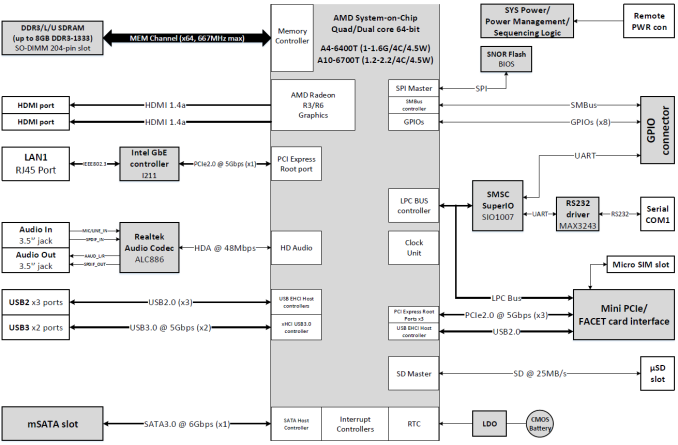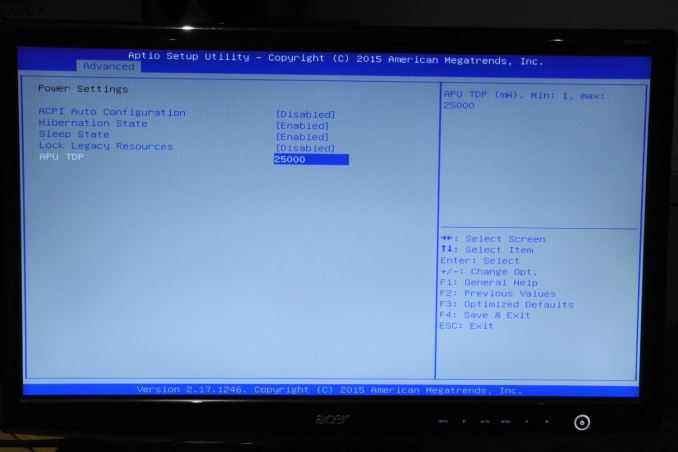Compulab fitlet-XA10-LAN Review: A Fanless AMD UCFF PC for Networking Applications
by Ganesh T S on April 19, 2016 8:00 AM EST- Posted in
- Systems
- Networking
- AMD
- Fanless
- Industrial PC
- Passive Cooling
- CompuLab
Hardware Aspects and BIOS Features
Our review kit came with four different components - the two main units, a fit-Uptime UPS and the heat-sink. The gallery below shows their different external aspects. The fit-Uptime contains a 18Wh Li-Po (lithium-polymer) battery that can deliver up to 60W (12V @ 5A) of power in case of power input failure. It needs an input of 12V @ 1A minimum to recharge itself. The aspect I like most about the fit-Uptime as well as the power adapter bundled with the fitlet units is the notch on the power delivery pin. Inserting it into the power input of the fitlet and twisting it around ensures that the power cord can never be accidentally yanked away from the PC. Obviously, the fit-Uptime is not network or USB-capable. Hence, it is not possible to determine how much charge is remaining in the internal battery at any point of time. Additionally, the target PC has no idea whether it is running on the mains or the fit-Uptime. However, this is not a concern if power failure is accidental / of short duration.
Despite the top lid being aluminum, the front and rear panels are made of plastic. Unfortunately, this makes the unit feel a little cheap in hand, but, as we found out later, it doesn't affect the thermal performance of the unit. On the front panel, we have the power button with a LED indicator, a USB 3.0 and two USB 2.0 ports, a micro-SD slot and 3.5mm audio jacks (surprisingly, not a combo audio jack, but separate ones for the headphone and microphone). One of the side panels is an extension of the top lid, and helps in securing it to the rest of the system. The rear panel has one USB 2.0 and one USB 3.0 port, two HDMI 1.4a ports and a RJ-45 port. A COM port is also available, and a serial port adapter is supplied along with the main unit. The other side panel is the face of the FACET card, and, in our case, it has the three extra LAN ports.
Getting into the internals of the unit is fairly simple, and Compulab even has video instructions for the same. Removing the bottom panel of our review unit revealed the back side of the FC-LAN FACET card. Underneath the top panel, we have a big chunk of metal covering the SoC. Though this metal chunk does come in contact with the top panel, there is no thermal paste involved. The SODIMM slot is also found under the top panel.
Moving back to the other side of the board, we find that it is easy to slide out the FACET card. This reveals a metal plate to create isolation between the mSATA card and the FC-LAN card. The CMOS battery as well as the micro-SIM slot are also accessible on this side. Changing the mSATA card is also fairly trivial, and involves the removal of just a couple of screws (one attaching the mSATA card to the metal plate, and another securing it to the motherboard). The gallery below shows our disassembly process, as well as the replacement of the original lid with the finned heat-sink version.
The block diagram of the motherboard with details of the I/O distribution is shown below.
The AMI BIOS has plenty of configuration tweaks available. The most important is the configurable TDP. This can be set between 1mW and 25W. Setting it to the maximum value is equivalent to completely unlocking the TDP limitations. By default, these values are set to 4500. However, both our units were configured for unlocked TDP. Compulab indicated that their currently shipping thermal solution is good enough to safely set the APU TDP to 25W.
Other configurable aspects include the memory dedicated to the GPU, SDIO access mode, fast boot configuration and security options (including key management for secure boot).






























50 Comments
View All Comments
rstuart - Tuesday, April 19, 2016 - link
The Kettop has less than 1/2 the warranty, is still bigger, doesn't have wireless, has VGA vs 2 x HDMI, 2xUSB-2 versus 3xUSB-2 + 2xUSB-3, no serial port, and no m-PCI expansion.But yeah, your right. Apart from that you are almost buying the same thing.
Lazn_W - Wednesday, April 20, 2016 - link
I guess my brief search didn't find anything quite so small.. But there are plenty of options in this arena, perhaps not quite so tiny, but if you need the wifi etc, and more horsepower.. you can get them, here is another MFG for example: http://www.amazon.com/Qotom/b/ref=bl_dp_s_web_1006...rstuart - Wednesday, April 20, 2016 - link
It's the same deal though isn't it? Your original point is there are cheaper options elsewhere, but while it's cheaper it's hardly the same thing. Good for a home router maybe - but doesn't have the ports to do much else. For a person wanting to put in in a remote office literally mega metres away and not touch it, the 1 year warranty doesn't send a good signal.As for the AMD vs Intel thing - I simply don't care. It's a bit of mystery to me why anybody would care. What I do care about is you load the OS on it, and it just works. They certainly do that. They've given me less compatibility headaches that any box I can remember. Even Debian stable "just works".
The one criticism I have of these CompuLab boxes is there is no TPM. TPM's are nice to have in boxes holding secure credentials in remote locations. Oh yeah and the choice of the Intel 7260 wifi module. It works wonderfully as a client, but as a master it only supports 13 stations which isn't enough.
zodiacfml - Friday, April 22, 2016 - link
I'm with you here. The size of the Compulab is impressive but for someone who is going to build and leave this in a not so nice location for human beings, the size difference is not much of an advantage for the Compulab.variab1e - Tuesday, April 19, 2016 - link
Is the J1900 going to be faster than the A10 Micro-6700T ?Lazn_W - Tuesday, April 19, 2016 - link
http://cpuboss.com/cpus/Intel-Celeron-J1900-vs-AMD...ganeshts - Tuesday, April 19, 2016 - link
That is a naive comparison. Only when we actually evaluate the *system* that the real performance comes out. Those 'bot' sites that just compare paper specifications never tell the full story.When I started the fitlet-XA10-LAN review, I was pretty sure the Braswell and Bay Trail SoCs would run circles around the A10 Micro-6700T. I was very surprised with the results - the difference lies in the thermal design - the unlocked TDP means the APU can dissipate a lot more power than what it is intended to in its target market (tablets for the A10 Micro-6700T).
So, we have the A10 Micro-6700T in the fitlet-XA10-LAN that was faster than any Braswell or Bay Trail passively cooled CPU with a larger form factor in *CPU* benchmarks. Credit to Compulab should be given when they deserve it :)
Lazn_W - Tuesday, April 19, 2016 - link
Sure, I was pointing out other options for those of us who prefer the blue team.And if you are willing to spend, there are Core i5/i7 based options out there too. If interested, look on Amazon.
WorBlux - Thursday, March 9, 2017 - link
And do they come with a standard 60 month (5 whole years) warranty?Bob Todd - Tuesday, April 19, 2016 - link
I'm surprised this thing wasn't able to NAT another ~100Mb/s. A $99 ERL can max out a gigabit FTTH connection.